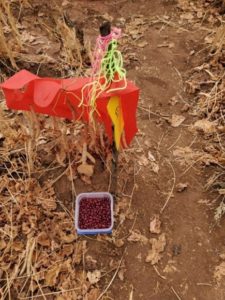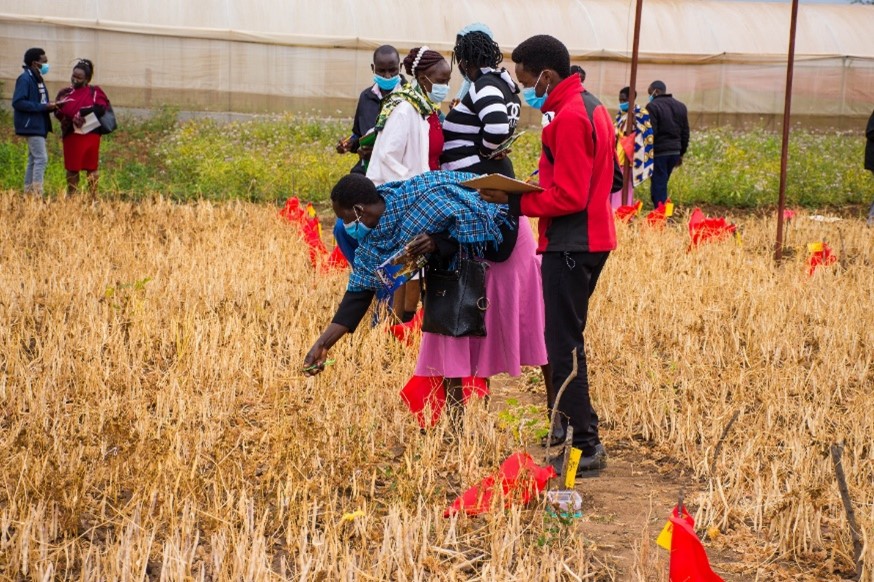Eileen Nchanji, Boaz Waswa, Patricia Onyango, Owen Kimani, David Karanja, and Wincaster Mutuli
Getting the right traits and the suitable variety for different clients is never easy.
Did you know that farmer’s approval for a variety to be released is very critical?
To breed common bean varieties preferred by men, women, and youth, farmers, consumers, traders and processors, breeders must involve all partners in the process. Often bean varieties are evaluated based on a bundle of traits among them yield, time to maturity, pod filling, pod shattering, size, color, pest, disease, and drought tolerance market demand and price, nutrition, and health.
Variety selection begins with a variety kit that contains various desired traits. The lines are planted over several seasons, each time selecting and narrowing the lines with desired traits. A Participatory Variety Selection (PVS) exercise involving key stakeholders is carried out to get opinions on the most preferred lines for further advancement.
The Bean Program in Kenya aims to develop an improved small red bean market class to replace the aging Wairimu (GLP 585) variety that is also low-yielding. As part of the PABRA approach of variety exchange and development, the Kenya Agricultural & Livestock Research Organization (KALRO) Bean Program received 253 (two hundred fifty-three) small red bean lines sourced from genebank at the Alliance of Bioversity International & CIAT (the Alliance) offices in Colombia and shared through the Alliance office in Kawanda, Uganda Bean Breeding Program. The variety trials were set up at four KALRO stations in Katumani, Kiboko, Thika, and Njoro starting in 2019.
The screening process has narrowed down to 40 promising lines now going for evaluation by stakeholders.
The trial at KALRO Katumani involved these promising lines. Eight checks were used in the trial: large and medium seeded varieties including Angaza, Faida, Nyota, KATX56, and four small-seeded varieties including KK Red Bean 16, KAT B1, KAT B9, and GLP 585.
On this day, 30 farmers, fifteen being women, were invited to evaluate and share their opinions on their preferred traits and lines. The farmers were drawn from the clusters representing bean growing areas in Machakos County and coordinated in collaboration with Biovision Africa Trust.
Guided by trained enumerators, the farmers took time to walk around the trial keenly evaluating the bean lines as per the criteria jointly agreed to. The exercise involved using a mix of the G+ Product Profile and Participatory Varietal Selections (PVS) tools. The G+ tool was developed through the participation of experts and stakeholders from the CGIAR Gender and Breeding Initiative (GBI), and piloted in collaboration with the CGIAR Excellence in Breeding Platform (EiB), funded by the Gates Foundation. Experiences in using these tools are being shared with other scientists through the Gender Researchers Equipped for Agricultural Transformation project with Cornell University. The gender-responsive PVS tool which is a combination of the G+ tool and PVS was developed by David Karanja and Eliezah Kamau, two breeders and Eileen Nchanji, Gender and Social Inclusion expert from the Alliance.
To minimize bias on the part of farmers, the bean varieties were coded. Ribbons of four different colors were used: light green, white, pink, and brown in the bean selection. Women selected light green ribbons as their preferred color and white ribbons as their least preferred color; men chose pink ribbons as their best color and brown ribbons as their least preferred color. The preferred ribbon colors selected by both men and women were used to select the most preferred bean genotypes, while the least preferred color ribbons were used in selecting the least preferred bean genotypes (Photo 2). Bean grains were placed on different lines so that farmers could tell the color and size, and a bag was placed in each line, where men and women farmers dropped their choices in these bags to avoid influencing each other. They were not allowed to discuss with each other as they made their choices. The final step involves tallying the responses given by the farmers and inferring the patterns and preferences.
Discussions with the men and women farmers showed differences and similarities in trait preferences and varietal choices. The farmers were interested in the yield and vigor of the bean plant. Women were more concerned with the color and size of the seed. They preferred medium and large-seeded varieties because of the less time spent on threshing and picking from the soil – reducing drudgery and quickly fills the bag – marketing. Men were more concerned about the pests and diseases, which are on the increase due to climatic variability.
“From what I have seen on these trails, it was grown on black cotton soil, and yet this variety is thriving. So if I take the seeds to my place, where it is red soil, with a little bit of manure, it will do much better than on this soil,” commented Mr. James Matheka on one of the varieties he sampled.
‘’Our initial aim was to evaluate the lines for a new small red bean type. Interestingly, the lines exhibited traits of drought tolerance. The rains were poorly distributed across time, with reports of dry spells and early cessation negatively impacting crop production at their critical stages, but still several lines were able to grow to maturity putting on pods. We will thus be following on drought tolerance as an additional trait to fight changing climatic conditions.’’ said David Karanja, Bean Program Leader.
Wincaster Mutuli, an agronomist at the station, also mentioned that moving forward, the screening will look at some pests and diseases such as anthracnose (Glomerella lindemuthiana), bean rust (Uromyces appendiculatus), and common bacterial blight (Xanthomonas axonopodis pv. phaseoli), which were identified to have affected the trial.
To increase varietal uptake or adoption by farmers, traders, processors, consumers etc. breeding programs need to think through social inclusivity, being mindful that one size does not fit all. It is this reason why we have developed and are piloting these tools which collect information from an intersectional lens. If farmers grow what the market wants, then we can have more resilient farming systems that meet the income, nutrition, and health of all value chain actors.

